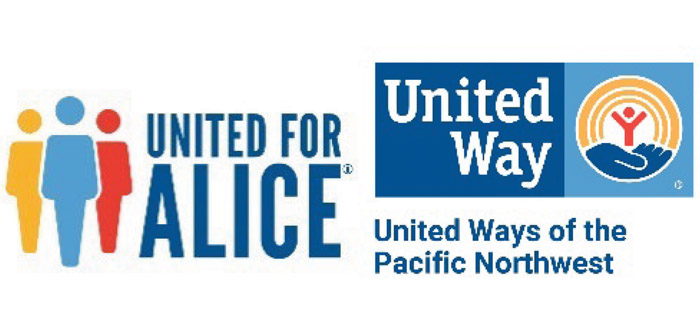Though wages for the lowest-paid jobs have risen across the country at the fastest rate in four decades, the number of households struggling to get by in Oregon grew by more than 19,000 from 2021 to 2022. As a result, a total of 764,160 households – or 45% – were living paycheck to paycheck, according to a new Update from United Ways of the Pacific Northwest and its research partner United For ALICE.
That calculation includes the 203,291 Oregon households in poverty as well as another 560,869 defined as ALICE (Asset Limited, Income Constrained, Employed), earning above the Federal Poverty Level but less than what’s needed to survive in the current economy. ALICE workers include childcare providers, home health aides and cashiers — those working low-wage jobs, with little or no savings and one emergency from poverty.
ALICE in the Crosscurrents: An Update on Financial Hardship in Oregon shows that while wages were increasing, so too were costs. For a family of four with an infant and a preschooler, the basic costs to live and work in Oregon, excluding tax credits, rose from $88,152 in 2021 to $96,084 a year later. Compounding the issue in 2022 was the loss of up to $15,000 in federal child tax credits and stimulus payments that this family had access to in 2021.
“The pandemic remains an ongoing challenge for ALICE families. As the stimulus packages and enhanced tax credits expire, our neighbors are essentially being forced back to budgets similar to the post-Great Recession era, limiting their ability to succeed. We must move beyond survival and talk about what stability means for these families,” said United Ways of the Pacific Northwest President & CEO Jim Cooper.
The findings in this one-year period are consistent with a more than decade-long trend: Since the end of the Great Recession, despite some ups and downs, the number of ALICE households in Oregon has been steadily growing. From 2010 to 2022, the total number of households rose by 13%, households in poverty decreased by 6% — and the number of ALICE households increased by 34%.
“The data is showing persistent and widespread financial hardship — a red flag that the current system isn’t working for ALICE,” said Stephanie Hoopes, Ph.D., United For ALICE National Director. “Current policy has not been enough to break down the barriers that trap ALICE households in financial hardship, from lack of access to housing and child care that’s affordable to inadequate community supports such as broadband internet.”
Additional insights include:
- From 2010 to 2022, people age 65 and over made up the fastest-growing age group in Oregon — and the group with the largest increase (47%) in the number of households struggling to make ends meet.
- Racial disparities persisted in the rates of financial hardship; 63% of Black and 54% of Hispanic households in Oregon were either in poverty or ALICE in 2022, compared to 43% of white households.
- Food assistance continued to elude many vulnerable families in Oregon. Partly due to the SNAP income eligibility level in the state (200% of the Federal Poverty Level), only 48% of all Oregon households in poverty and 23% of all ALICE households participated in SNAP in 2022.
About United Ways of the Pacific Northwest:
United Ways of the Pacific Northwest (UWPNW) is the regional trade association for 34 local United Ways in Washington, Oregon, and Idaho. United Ways in the Pacific Northwest are committed to improving lives by mobilizing the caring power of communities to advance the common good in the areas of education, income, and health. Our mission is to advance the common good throughout the Pacific Northwest by enhancing the individual and collective ability of member United Ways to impact their communities and collaborate on regional and statewide issues.
About United For ALICE:
United For ALICE is a U.S. research organization driving innovation, research and action to improve life across the country for ALICE (Asset Limited, Income Constrained, Employed) and for all. Through the development of the ALICE measurements, a comprehensive, unbiased picture of financial hardship has emerged. Harnessing this data and research on the mismatch between low-paying jobs and the cost of survival, ALICE partners convene, advocate and collaborate on solutions that promote financial stability at local, state and national levels. This grassroots ALICE movement, led by United Way of Northern New Jersey, has spread to 31 states and includes United Ways, corporations, nonprofits and foundations in Arkansas, Colorado, Connecticut, Delaware, Florida, Georgia, Hawai‘i, Idaho, Illinois, Indiana, Iowa, Kansas, Louisiana, Maine, Maryland, Michigan, Minnesota, Mississippi, New Jersey, New York, North Carolina, Ohio, Oregon, Pennsylvania, South Carolina, Tennessee, Texas, Virginia, Washington, Washington, D.C., West Virginia and Wisconsin; we are United For ALICE.


